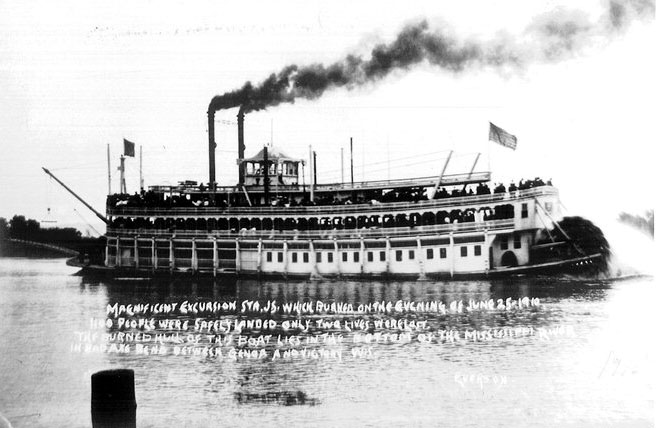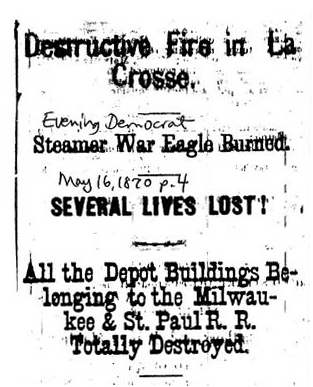Accidents & Disasters:
Resources
—Shipwrecks—
Author:
La Crosse Public Library
Creator:
La Crosse Tribune
Description:
Newspaper articles related to the fire and sinking of the steamboat "J. S." On June 25, 1910, the excursion Steamboat "J. S." burned and sank near Victory, Vernon County, with close to 1000 people on board. The trip left from Lansing, Iowa, and was bound for La Crosse, Wis., 30 miles up the Mississippi River. At 6 p.m. the "J. S." left La Crosse to make her return trip.
Fire was detected and the pilot steered the boat toward shore as the passengers panicked. Within two minutes of the ringing of the fire bell, Pilot George Nichols pulled the "J. S." alongside Bad Axe Island where crew members pulled out the gangplank for passengers to exit. In the end, two people were killed, including a man held in the boat's hold for being disruptive and intoxicated. The boat burned and sank about 300 feet from shore.
Fire was detected and the pilot steered the boat toward shore as the passengers panicked. Within two minutes of the ringing of the fire bell, Pilot George Nichols pulled the "J. S." alongside Bad Axe Island where crew members pulled out the gangplank for passengers to exit. In the end, two people were killed, including a man held in the boat's hold for being disruptive and intoxicated. The boat burned and sank about 300 feet from shore.
Author:
La Crosse Public Library
Description:
Newspaper articles related to the explosion of the steamboat "James Malbon." James Malbon, a La Crosse steamboat captain, was piloting a new steamboat named for him when a flaw in the boiler caused it to explode on July 30, 1872, near North McGregor, Iowa. At the time of the accident, the 29 year-old captain was in the pilot house and was killed in the explosion. According to newspaper accounts, eight people were killed or lost, 13 saved and four were listed as wounded. The official inspector's report said eight of the crew were killed and five injured.
The cost of construction of the 120 ton boat was $14,000 and it was built for the Keator Lumber Company. This explosion caused a stir as raft boats, such as the "James Malbon," were more likely to explode than the more powerful packet boats. In the end, inspectors determined that the cause of the accident was great recklessness and carelessness on the part of W. Harvey Pierce, second engineer, on watch at the time. His license was revoked. The engines were salvaged and later placed in the Robert Ross built in 1873.
The cost of construction of the 120 ton boat was $14,000 and it was built for the Keator Lumber Company. This explosion caused a stir as raft boats, such as the "James Malbon," were more likely to explode than the more powerful packet boats. In the end, inspectors determined that the cause of the accident was great recklessness and carelessness on the part of W. Harvey Pierce, second engineer, on watch at the time. His license was revoked. The engines were salvaged and later placed in the Robert Ross built in 1873.
Author:
La Crosse Public Library
Description:
A collection of newspaper articles about the burning of the steamboat "War Eagle." On May 14, 1870, the "War Eagle", a sidewheel packet boat, arrived at La Crosse. She dropped off passengers at the city landing at State and Front streets, then proceeded north to the railroad depot on the Black River to take on freight and await the midnight train from Milwaukee. When the train arrived, passengers and freight were transferred to the "War Eagle" for transport to St. Paul, MN. Among the items loaded were wooden barrels filled with "Danforth's Non-Explosive Petroleum Fluid" - a kind of lamp oil. While not explosive, it turned out to be quite flammable.
While loading the barrels onto the "War Eagle," it was reported to Capt. Thomas Cushing that one of the barrels was leaking. The Captain ordered the boat's carpenter to fix it. Soon, the barrel was ablaze as well as the ship's carpenter. He jumped into the water to extinguish the fire from his clothes. The barrel was rolled off the left side of the boat, a barge lay alongside, preventing the crew from rolling it into the water. Fire and black smoke rapidly spread to the wooden boat. Only five people are believed to have lost their lives as a result. However, many other buildings and trains were damaged, and freight lost as well as the steamboat "War Eagle."
While loading the barrels onto the "War Eagle," it was reported to Capt. Thomas Cushing that one of the barrels was leaking. The Captain ordered the boat's carpenter to fix it. Soon, the barrel was ablaze as well as the ship's carpenter. He jumped into the water to extinguish the fire from his clothes. The barrel was rolled off the left side of the boat, a barge lay alongside, preventing the crew from rolling it into the water. Fire and black smoke rapidly spread to the wooden boat. Only five people are believed to have lost their lives as a result. However, many other buildings and trains were damaged, and freight lost as well as the steamboat "War Eagle."


